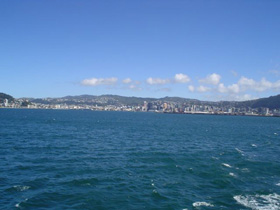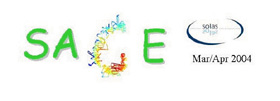Cruise
Log: Thursday, April 15, 2004
|
March
|
|
Sun
|
Mon
|
Tue
|
Wed
|
Thu
|
Fri
|
Sat
|
|
|
1
|
2
|
3
|
4
|
5
|
6
|
|
7
|
8
|
9
|
10
|
11
|
12
|
13
|
|
14
|
15
|
16
|
17
|
18
|
19
|
|
|
|
|
|
|
|
|
|
|
|
|
|
|
|
|
|
|
April
|
|
|
|
|
|
|
|
|
|
|
|
|
|
|
|
|
|
|
|
|
|
15
|
16
|
17
|
|
18
|
19
|
20
|
21
|
22
|
23
|
24
|
|
25
|
26
|
27
|
28
|
29
|
30
|
|
|
| |
 |
|
Back to Wellington, where it all began (Photo
by Peter Minnett). |
| |
 |
| The
Sage logo shows the track of the Tangaroa following the tracer labeled
patch around an eddy. |
| |
| |
The final
day
Contributors:
Mike Harvey and Murray Smith, NIWA
As the SAGE voyage
comes to an end, it is only fitting that we have the best weather of the
month. After all, we did ask for strong wind conditions to assist in giving
high gas exchange, and we certainly got it. So now as we bask in sunshine
amidst the warm sub-tropical waters, we have been reflecting on the voyage;
a voyage with exciting, challenging, intriguing and unexpected aspects
that make the scientific endeavor so rewarding.
There have been several highlights. The first was the opportunity to make
dual-tracer gas exchange coefficient measurements at higher wind speeds
than had previously been sampled. The high wind speeds were also a feature
for the MAERI remote sensing of sea surface skin
temperature, and microwave radar measurements of waves.
A second highlight was to find that we did not stimulate a phytoplankton
bloom with the addition of iron, a result unlike previous experiments.
This has the biologists intrigued, and will keep them busy examining the
results of the onboard experiments to determine the missing factor(s).
This is the final wrap-up for the fieldwork, and now the scientific personnel
go their separate ways to begin the lengthy work of analyzing the data
in detail. From this will emerge an improved knowledge of the biological
and physical controls of the interchange of gases between the ocean and
atmosphere, and the subsequent role in influencing climate change.
With a goodbye
from the whole SAGE science team, we say a very big thank you to the many
individuals and organizations that made SAGE possible. We owe special
thanks to Captain Roger Goodison, his officers and crew for rising to
the challenge and providing us with the highest level of logistic support
and the required flexibility to run the many and varied deployments and
operations of SAGE. The range and amount of equipment presented a considerable
engineering challenge and this was handled extremely competently by the
engineers Allan Harvey and Fred de Jager, along with Greg Foothead and
the staff at the NIWA workshop in Wellington. We also thank the ground
support back at NIWA coordinated by Mark Hadfield, assistance with ocean
color provided by Steve Wilhelm at University of Tennessee, IT support
from Chris Edsall and the IT team, and the many participating
organizations that provided equipment for the voyage. None of this
would have happened without the funding of the New Zealand Foundation
for Research, Science and Technology (FRST) through programs (C01X0204)
"Drivers and Mitigation of Global Change" (C01X0223), "Ocean
Ecosystems: Their Contribution to NZ Marine Productivity," the US
National Science Foundation, the International Science and Technology
(ISAT) fund, the many collaborator institutions who also provided support,
and of course NIWA itself.
|